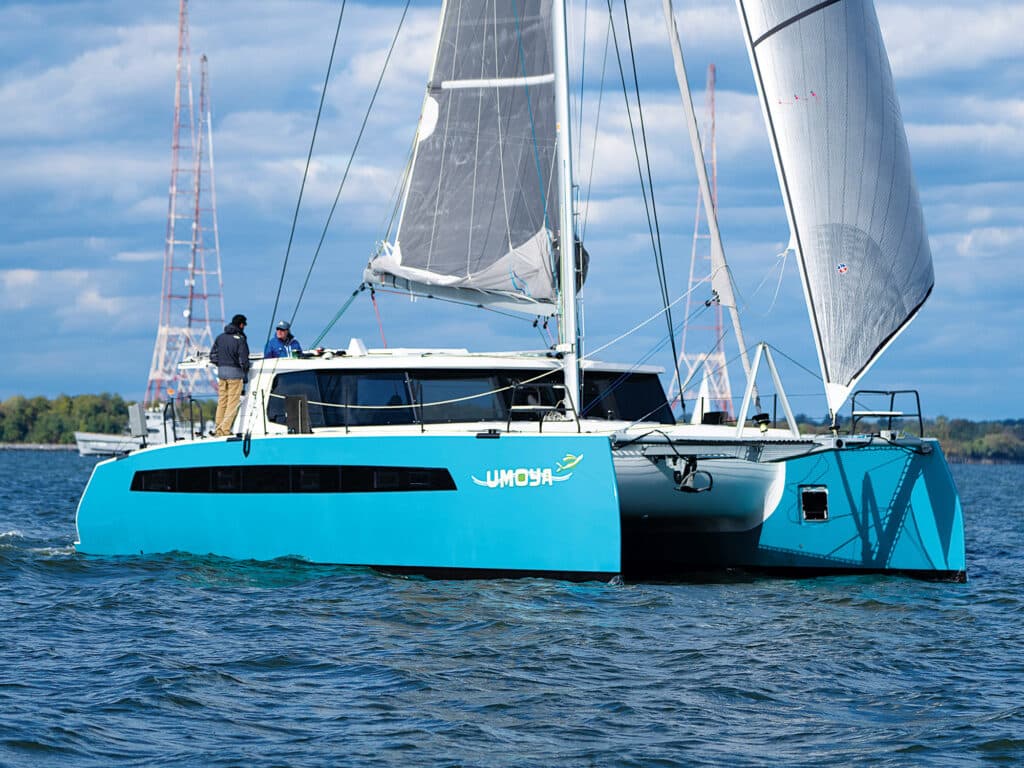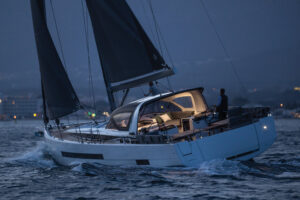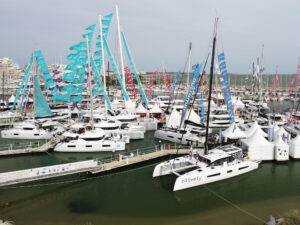
This February, I was on a powerboat off Anse Marcel on the French side of the Caribbean island of Saint-Martin when a fleet of fast performance-cruising multihulls set sail into the windy Anguilla Channel for the rally portion of the annual Caribbean Multihull Challenge. A pair of Balance 442 cats named Sage and Umoya, with reefed mains and drawing spinnakers, were blasting their way into the channel’s whitecapped waters, roiled by the 20-plus-knot easterly trade winds.
Though they were practically the smallest cats in the fray, the 442s were more than holding their own against the bigger craft, which included a quartet of Balance 482s (including company president and founder Phil Berman’s In Balance). Five months earlier, during our annual Boat of the Year contest, I’d sailed the very same Umoya in somewhat lighter air. Now I knew what the 442s looked like under sail in sportier conditions while hauling the mail: buoyant, sprightly and packed with horsepower. The yacht’s angular aesthetics are crisp, clean and, to my eye, quite fetching. There’s a deck-stepped mast and a working sail plan consisting of a big, square-topped fully battened mainsail and self-tacking jib; relatively narrow hulls with high freeboard and curved, wave-piercing bows that maximize waterline length; an integral sprit for the reaching and running sails; and a substantial coachroof topped with solar panels
and accented by generous, tempered-glass windows.
Balance Catamarans are built in South Africa, where almost 500 employees operate out of two separate facilities, building about 25 boats a year spanning several models. They all share, as Berman told me, a common purpose and the same DNA: They’re performance-oriented, liveaboard cruising boats that are bluewater capable and sail well on all points of sail. The carbon-infused daggerboards, a feature shared with every model in the brand, are largely responsible for their notable windward ability.
The build, systems and layout are, at once, both complex and straightforward. The hand-laid hull and deck laminates are vacuum-bagged and employ a vinylester outer skin with a polyester inner skin sandwiching a closed-cell foam core with carbon reinforcements in high-load areas (and in the structural crossbeams). To keep the vessel as light as possible without compromising strength, the bulkheads and furniture are foam-cored.
While the contemporary construction techniques and materials are decidedly high-tech, the power and charging systems aren’t especially complicated; Berman said that another overall goal was to keep the boats as simple as possible to sail and operate. For example, Ed Sherman, our BOTY judge who concentrates on systems, was somewhat surprised that the builder did not opt for the digital-switching configurations so prevalent now across the industry. Still, he liked what he saw, perhaps even more so.
“This boat is yet another variation of the ‘no-dedicated-onboard-generator direction’ we are moving in. It uses integral engine-driven alternators—in this case, a pair of them—that create 48-volt power and run this power through Victron converters to run 24- or 12-volt appliances (or the 48-volt equipment just becoming available in the marine marketplace). Energy is stored in lithium-ion battery banks and can be run through DC/AC inverters to run 120- or 220-volt AC appliances. I see the future of onboard electrical systems on this boat.”
The accommodations plans are also well-thought-out. At 44 feet length overall, and with the daggerboards to account for, this boat has less interior volume than you’d find on other production cats in this size range. But the Balance team maximized the space available, particularly with the big sliding-glass doors that, when open, incorporate the interior lounge, galley and salon with the cockpit. There’s a choice of four staterooms or, as we had on our test boat, three. In the latter setup, a pair of double-berth staterooms are to port (one with an athwartship berth forward and a fore-and-aft bunk aft) while a dedicated owner’s stateroom spans the hull to starboard. In either configuration, stowage is abundant.
The deck also has nifty things of note: the dual mainsheet system that allows the boom angle to be fine-tuned, negating the need for a traveler; the taut, split trampolines forward that provide an excellent bridle system for the ground tackle centered between them; the grab rails on the coachroof top, serving as handholds and rain catchers; the dedicated winch forward for the spinnaker halyard or code zero; and the huge sail locker that can be accessed from the deck. The davit system also works well. Ullman sails are standard. For electronics, owners can choose Garmin or Raymarine kit.
It was under sail, however, that I truly began to appreciate the 442’s proportions, and came to realize what an ideal-size boat this is for a cruising couple. It’s large enough to address most any cruisers’ plans and itinerary, but not so big that you need to bring additional crew on board to go cruising.
Our test sail was conducted in considerably more mellow conditions than those off Anse Marcel, but in a building southerly that topped out around 15 knots, there was more than enough breeze to strut the 442’s stuff. The VersaHelm that’s offered on every Balance lives up to its name: The convertible wheel can be locked down at cockpit level in inclement conditions, out of the weather, though thanks to those wide windows, there’s good visibility. Or it can be raised up to the elevated helm station to starboard, where a pair of winches and three sets of rope clutches serve the color-coded running rigging that’s all right at hand. The engine controls and instrumentation are mounted here as well, making this an easy boat to sail solo.
We tacked upwind to gain sea room, gliding along at a pretty effortless 8-plus knots, then swapped the jib for the code zero, turned and burned on a broad reach, and easily topped 11 knots. That was clearly the cat’s sweet spot. It was evident that you could easily match that speed for miles and miles and, on passage, knock out consistent 200-plus-mile days.
To sum up, what you get with the Balance 442 is comfort at anchor and performance underway. Sounds to me like it all balances out.
Balance 442 Specifications
| DRAFT | 3’9″/7’1″ |
|---|---|
| SAIL AREA | 1,205 sq. ft. |
| DISPLACEMENT | 26,014 lb. |
| D/L | 134 |
| SA/D | 22 |
| WATER | 184 gal. |
| FUEL | 212 gal. |
| MAST HEIGHT | 65’5″ |
| ENGINE | Twin 40 hp Yanmar diesels |
| DESIGN | Philip Berman/Anton du Toit |
| PRICE | $1,150,000 |
| balancecatamarans.com |
Herb McCormick is former editor-in-chief of Cruising World and the yachting correspondent for The New York Times. The author of five nautical books, he’s owned several sailboats, including his current Pearson 365 and Pearson Ensign.








